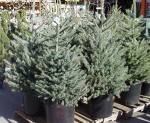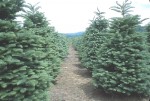The holidays are upon us and beginning this weekend, many of us start the season with a fresh-cut Christmas tree. On Nov. 25 on Fox 59’s Morning News, the Hoosier Gardener offers tips for selecting and caring for our trees.
Scotch pine, white pine and fraser fir are among the most popular selections for fresh cut trees. Scotch pine has stiff branches with good needle retention. White pine has long, soft needles, but weak branches for holding heavy ornaments. Fraser fir has stiff branches and short needles that are very fragrant.
Other tips:
- Measure the space in your home where the tree will go. That way you’ll know what height and width to shop for.
- Ask the retailer when the trees arrived. Do they arrive all at once or are there several shipments throughout the holiday season?
- Test for freshness by bending a few green needles backwards. Gently bend a branch. If the needles fall off or the branch breaks, the tree is not fresh.
- Other signs of an older, cut tree are excessive needle loss, discolored foliage, musty odor, needle pliability, and wrinkled bark. If in doubt, go to another tree lot.
- Ask the retailer to make fresh cut at the base of the trunk. You’ll have about six hours to get the tree in water before the cut seals up. At home, sit the tree in a bucket of water until you are ready to place it in the stand.
- If that’s not possible, take off ½ to 1-inch of the trunk with a fresh cut, then place in the stand. Make the cut straight across and not at an angle. A straight cut provides the greatest surface for the tree to take up water.
- The temperature of the water is not critical and there’s not need to add amendments to the water.
- Once in the stand, check the water level frequently to make sure it is high enough to cover the base of the tree.
- Make sure the tree is not near a heat source, such as a register or vent, heater or fireplace.
- Check your tree lights to make sure no wires are frayed. Always turn off the lights when going to bed or leaving home.
Keep an eye on the tree’s freshness. If it looks and feels dry, remove it and take it to the recycling center. In Indianapolis and many other communities, there are several tree drop off sites. There, the trees are ground up for mulch for parks, along trails and other areas.
Or, move the tree outdoors and lean it against a fence or shade tree. It should hold its needles throughout winter and provide a resting space and seasonal shelter for birds.
Christmas tree stats:
Christmas trees are grown in all 50 states. The top producing states are Oregon with 6.9 million trees harvested in 2007; North Carolina with 3.1 million trees; Michigan with 1.6 million; and Pennsylvania, 1.2 million. Indiana ranks 11th with tree farms harvesting 198,899 in 2007.
About 15,000 farms in the United States have about 350 million acres growing about 350 million Christmas trees in various stages, from seedlings to the 6- to 7-feet height that is ready to harvest. The farms employ 100,000 full- or part-time workers. In the 15 years it takes a tree to reach harvest size, this renewable resource captures carbon dioxide, helps keep the soil cool and shaded and provides shelter and nesting sites for birds. For each tree harvested, farmers plant one to three seedlings the following spring.
When we recycle the trees by chopping them into mulch, we return them to the environment. Or, we can delay that return by propping it up against a fence or shade tree for birds to use as a seasonal shelter. The tree can be turned into mulch in spring.
Terms:
- Cut tree — grown and harvested for the holiday season. Purchased at tree lots, garden centers or at tree farms. Recycle after the holidays.
- Balled-and-burlapped — a live tree with the root ball intact, wrapped in burlap. Transplant to the landscape after the holidays.
- Containerized — a live tree grown in plastic container. Transplant to the landscape after the holidays.
More tree tidbits:
- Thirty-five percent of us will buy a fresh cut or live tree this year. Eighty percent of those will buy pre-cut trees; 9 percent will buy live trees for replanting in the landscape after the holidays.

Live trees are grown in containers or as balled-and-burlapped specimens. Prepare the hole for planting in fall. Plant as soon as possible after the holiday. Photo courtesy Colorado State University.
When opting for a live tree, prepare the planting hole in fall or early winter before the ground freezes. After planting, make sure to water the transplant well. The best choices are Norway and other spruces (Picea), Eastern white pine (Pinus strobus) and white fir (Abies concolor).For other tips, read Purdue University’s Living Christmas Trees for the Holidays and Beyond.
- In the United States, we will purchase about 28.1 million trees and spend about $1.03 billion. We will spend an average of $40 to $50 for our tree.
- The most common Christmas tree species: balsam fir, Douglas fir, Fraser fir, noble fir, Scotch pine, Virginia pine and white pine.
Get your tree from a farm
You also can visit tree farms to hand pick your tree, which is cut on the spot and loaded on your vehicle. This is the way to make sure your tree is a fresh as possible.
Most tree farms keep their fields very well groomed, but there are some things that are beyond the farmer’s control. Be careful of tree stumps, brambles, vines, uneven ground and sharp saws.
Go to the farm prepared for a day in the country. Wear comfortable shoes and old clothes. Bring rain gear if the weather is threatening. The “cutter downers” and the “loader uppers” should also have gloves.
Saws are usually provided by the farm operator. Check ahead of time.
Some farms measure and price their trees individually, others sell them by the foot. Ask about the pricing policy before heading out in the field. Here are some more tips:
- Head out to the field and select the tree that fits your predetermined needs.
- Check the trunk to be sure that it is sufficiently straight. Keep in mind that pines will usually have, at least, some crook in their trunks.
- Check that the tree has a sufficiently long handle to accommodate your stand.
- In fall, all conifers drop or shed a certain portion of their oldest needles. This is a normal part of the life cycle of the tree. This phenomena occurs because the tree is preparing itself for winter. Most farms provide shaking, or blowing, services so that you will depart with a perfectly clean tree.
- Cutting the tree is easiest as a two person project. The “cutter downer” usually lies on the ground. While the helper holds the bottom limbs up.
- While the cut is being made, the helper should tug on the tree lightly to ensure that the saw kerf remains open and the saw does not bind. The tugging force should be applied to the side of the tree opposite the cut.
- Take the tree to the processing area where it will be cleaned and netted. Netting makes transporting and handling the tree substantially easier.
- Now you’re ready to load up and head home to decorate your real Christmas tree.
Source: National Christmas Tree Association
Resources — To learn about the different species of holiday trees and their care, please visit the National Christmas Tree Association’s Web site.
Find a tree farm near you:


